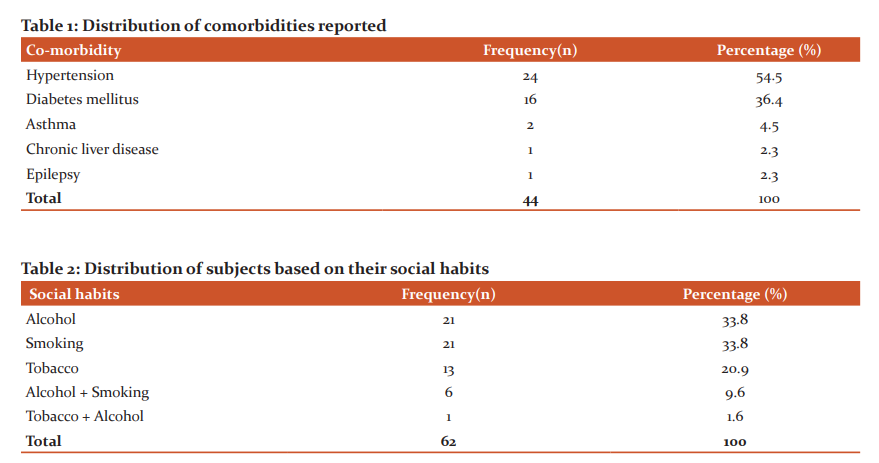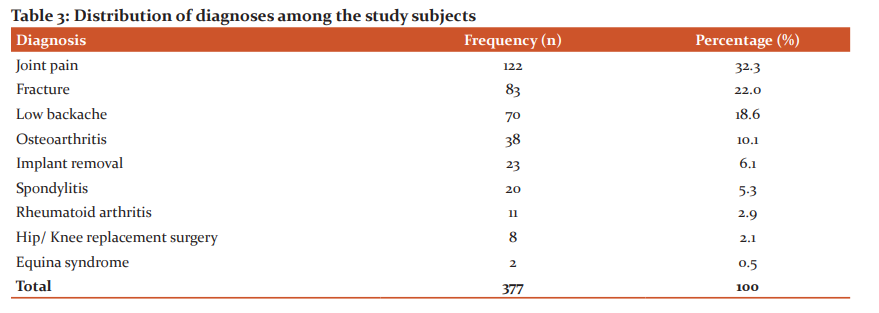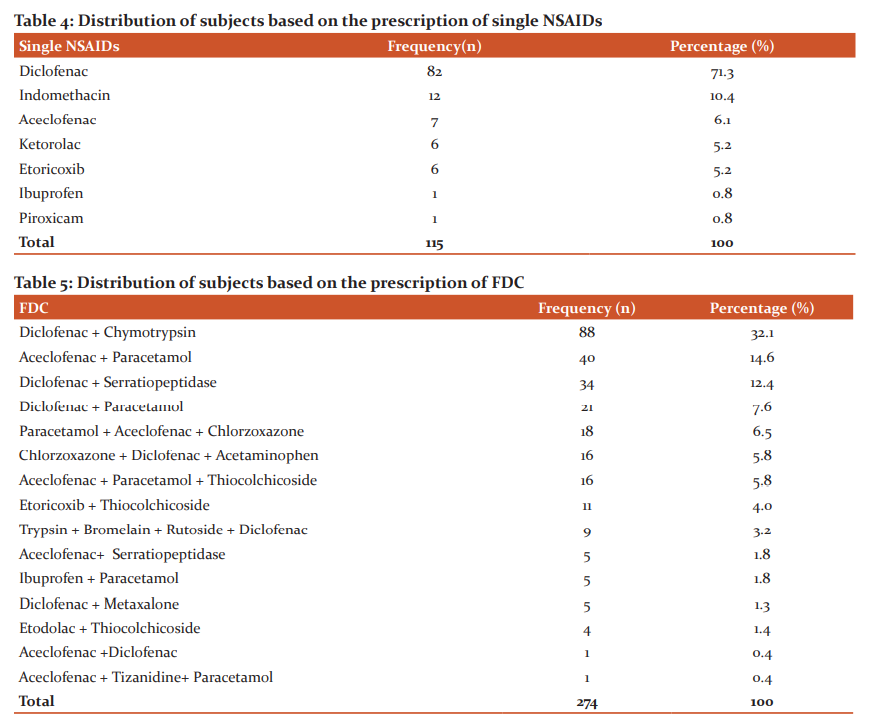IJCRR - 13(3), February, 2021
Pages: 126-131
Date of Publication: 03-Feb-2021
Print Article
Download XML Download PDF
Usage Pattern of Gastroprotective Agents Among Patients Prescribed with NSAIDS in Orthopedics Department
Author: Lynel Venston Saldanha, Josina John, Abdul Javad K, Siddarth M. Shetty, Sharad Chand, Juno J Joel, Bharath Raj KC, Nandakumar UP
Category: Healthcare
Abstract:Introduction: Gastroprotective agents are prescribed in the department of orthopaedics to prevent and to treat gastric toxicity due to analgesics including NSAIDs. Objective: The present study aimed to analyze the prescribing pattern of gastroprotective agents among patients prescribed with NSAIDs in the department of orthopaedics and to identify the most common gastroprotective agent co-administered. The study also aims to estimate the average cost of gastroprotective agents. Methods: A prospective observational study was conducted for six months among 370 inpatients of the orthopaedics department. Relevant details on the usage pattern of gastroprotective agents were collected from the case sheets of the patients and were analyzed by descriptive statistics. Results: Out of 370 subjects enrolled, 257 (69.5%) were males and 113 (30.5%) were females. The most frequently prescribed single NSAID agent was diclofenac 82 (71.3%) and the fixed-dose combination was found to be diclofenac + chymotrypsin 88 (32.1%). Among the various proton pump inhibitors and H2 receptor antagonists prescribed, pantoprazole was found to be the most commonly prescribed agent 205 (61.4%), followed by rabeprazole 96 (28.7%). The average cost spent by a patient on the gastroprotective agent during their hospital stay was found to be 65.85\?52.45 INR. Conclusion: The present study concluded that the majority of patients were prescribed with gastroprotective agents along with NSAIDs. The present study provides an insight into various healthcare professionals on the importance of rational use of medications among subjects.
Keywords: Gastroprotectives, NSAIDs, Pantoprazole, Prescribing pattern, Average cost
Full Text:
INTRODUCTION
Non-steroidal anti-inflammatory drugs (NSAIDs) and opioids are the majorly used medications to ameliorate pain and inflammation. Opioids are rarely used because of their abuse potential and adverse effects including CNS and respiratory depression. This gives way to the use of NSAIDs which are organic acids involved in inhibiting cyclooxygenase-1 and cyclooxygenase-2 (COX-1 and COX-2)enzymes. Inhibition of these enzymes causes decreased production of prostaglandins.1,2 NSAIDs have antipyretic properties because of the inhibition of interleukin and tumour necrosis factor-alpha. The anti-thrombotic effects of NSAIDs are due to the inhibition of thromboxane.1 The anti-inflammatory properties of NSAIDs are because of the inhibition of COX-2 mediated prostaglandin synthesis. They can only stop a part of the inflammatory process because they do not block leukotrienes and platelet-activating factors.2 Prostaglandins are involved in gastric protection by helping in the inhibition of breakdown of gastric mucosa and thereby preventing the formation of an ulcer. However, they do not offer complete protection. Due to the ulcerogenic properties of NSAIDs, it is usually appropriate to prescribe them along with drugs that are involved in the protection of gastric mucosa to reduce pain and complications of excess bleeding.2,3 Studies conducted to analyze the usage pattern of any drugs would help to perform modifications in the pattern of its prescription, which ultimately increases the therapeutic benefit and helps in reducing the associated adverse effects.4-7 A significant price variation of drugs can create a financial burden, especially on economically backward patients.8 Hence, it is very important that the treating physicians must be made aware of the cheapest drugs out of the various brands available in India so that the patient bear the fewer burden of treatment costs. Thus, the present study was conducted to analyze the usage pattern of gastroprotective agents along with NSAIDs among in-patients of the orthopaedics department.
MATERIALS AND METHODS
A prospective observational study was conducted for six months in the department of orthopaedics after obtaining approval from the Institutional Ethics Committee (REF: NGSMIPS/IEC/22/2019-20). Inpatients of either gender, aged above 18 years, prescribed with at least one NSAID in the department of orthopaedics were enrolled in the study. A total of 370 patients meeting the inclusion criteria were enrolled in the study after obtaining the voluntary informed consent from the patients. A suitable data collection form was prepared to collect and document the data including the details of patient demographics and the prescription pattern. Relevant details of the study subjects such as their age, gender, social habits, comorbidities, and diagnosis were obtained from the patient’s case records. Data including the name and dosage of NSAIDs and gastroprotective agents prescribed, type of therapy and other co-prescribed drugs were also noted. The average cost spent on gastroprotective agents by the subjects was calculated.
Frequency and percentage were used to analyze the gender, domiciliary status, comorbidities, social habits, diagnosis, the prescription pattern of NSAIDs and gastroprotective agents. Mean and the standard deviation was used to summarize the age and average cost of gastroprotective agents spent by subjects. The average cost was expressed in Indian currency.
RESULTS
Demographic details of the study subjects
Out of 370 subjects enrolled, 257 (69.5%) were males and 113 (30.5%) were females. The majority were found belonging to the age group of 21 to 40 years, 168 (45.4%) followed by 41-60 years, 143 (38.6%) and 61-80 years, 42 (11.35%). The mean age of the study population was found to be 42.04 ± 14.30 standard deviation. Distribution of subjects based on domiciliary status showed that 286 (77.3%) were found belonging to the rural background and 84 (22.7%) were from an urban background.
Distribution of co-morbidities presented by the subjects
Out of the total subjects enrolled, 38 patients reported a total of 44 co-morbidities. The most common comorbidity was found to be hypertension 24 (54.5%), followed by diabetes mellitus 16 (36.4%). The details are summarized in Table 1.
Distribution of subjects based on their social habits
Sixty-two (16.8%) patients were found to be present with at least one social habit. Out of which, 21 (33.8 %) were alcoholics and 21 (33.8%) were smokers. The details are summarized in table 2.
Distribution of various diagnoses among the study subjects
A total of 377 orthopaedic related diagnoses were made among 370 patients. The most frequently diagnosed condition among the study population was found to be joint pain 122 (32.3%), followed by fracture 83 (22.0%) The details are given in table 3.
Prescribing pattern of NSAIDs among study subjects
A total of 389 NSAIDs were prescribed among 370 patients. Out of which 115 were prescribed as single NSAIDs, whereas 274 were given as fixed-dose combination. Among the total single NSAIDs prescribed, Diclofenac 82 (71.3 %) was found to be the highest followed by Indomethacin 12 (10.4 %) and in fixed-dose combination, diclofenac + chymotrypsin 88 (32.1%) was highest, followed by aceclofenac + paracetamol 40 (14.6%) as depicted in table 4 and 5. Three hundred forty-eight (94%) patients were prescribed with monotherapy of NSAIDs followed by combination therapy 22 (6%).
Distribution of subjects based on the prescription of gastroprotective agents.
Out of 370 subjects enrolled, 334 (90.3%) were prescribed with gastroprotective in combination with NSAIDs, and 36 (9.7%) subjects were not prescribed with gastroprotective agents. Among 334 subjects, the most commonly prescribed agent was found to be Pantoprazole 205 (61.4%), followed by Rabeprazole 96 (28.7%). The details are summarized in Table 6.
Distribution of Antibiotics prescribed among subjects
A total of 169 (45.6 %) antibiotic agents were prescribed among the total subjects enrolled. The most commonly prescribed antibiotic was found to be cefuroxime 75 (44.3%). The details are summarized in table 7.
Estimation of the cost spent by subjects on gastroprotective agents
The mean cost spent by a patient on gastroprotective agents per day was found to be 8.71 ± 3.95 standard deviations. The per-day cost spent varied from 0.65 to 24.2 INR. The mean cost spent by a patient on gastroprotective agents during their hospital stay was found to be 65.85 ± 52.45 standard deviations. The total cost spent by the patient ranged from 2.62 to 350.40 INR.
DISCUSSION
The results obtained in gender-wise distribution was supported by other previously conducted research.9,10However, one study exhibited opposing results as females (57.6%) were the predominant subjects in this study.11 A a large number of patients who were prescribed with NSAIDs belonged to the age group 21-40 years (45.4%). Similar results were discussed in two other studies wherein, 27.7% and 41% of the study subjects belonged to the same age group of 21-40 years respectively.12,13 However, this result was not in agreement with a study done in 2018in which most of the patients could be categorised in the age group of 40-60 years (44.5%).11 The age of the study subjects ranged between 18-83 years with a mean value of 42.04±14.3 standard deviation. This aspect was supported by the study results of Kim T J and his team.14 In the current investigation, hypertension (54.5%) was found to be the most frequent co-morbidity reported among the subjects. The results of a study performed by a group of researchers also showed hypertension (12.4%) as the most common co-morbidity among their study population.14 However, diabetes mellitus was found to be the major co-morbidity in a drug utilisation study conducted in Kerala.11While analysing the final diagnoses of the study population, the results were in contradiction with a study where the majority of the recruited participants were confirmed cases of osteoarthritis (36.1%). Comparable results were obtained in a study by Choudhury D K and his team as a predominant diagnosis of fractures (61%) was noted amongst the patient population.15,16
In this current study, a large proportion (94.0%) of the subjects received monotherapy with NSAIDs whereas only 6.0% of the patients were recipients of combination therapy. Corresponding results were obtained in two other studies wherein, 55.5% and 98.9% of their patients were prescribed with NSAIDs as monotherapy.11,16 However, the results of another research conducted in 2016 were inconsistent with our report as combination therapy was preferred over monotherapy in this population.17 Diclofenac (71.3%) was found to be the most commonly prescribed NSAIDs among patients who received therapy with the single analgesic agent and this finding agreed with the study carried out by Choudhury DK and his team. However, in another study, Etoricoxib was observed to be the most commonly prescribed agent (33.34 %).11,16 The fixed-dose combination of NSAIDs prescribed in the present study was found to be inconsistent with the conclusions of Chaudhary DK and his team.16
In our study, gastro-protective agents were co-prescribed with NSAIDs among 90.3% of the patients and comparable results were noted in a different study since 95% of the study population who were prescribed with NSAIDs also received co-administration of gastro-protective agents.18On analysing the prescription pattern of different gastroprotective agents, the results of a study were similar to the present study as proton pump inhibitors (73.54%) were the most frequently prescribed agents in their study. In contradiction, Ranitidine was found to be the most commonly prescribed agent in studies conducted during the years, 2015 and 2016.16,19 The judicious use of drugs reduces the economic burden on the patient significantly, especially among those who are financially backward. Hence, attempts to increase the physician’s awareness of the pharmaco-economic aspects of medication and the various brands available in the market should be done at regular intervals. These aspects of treatment are often neglected while they remain crucial in a developing nation like India. This will directly benefit the patients and the clinical pharmacist is the most recommended professional to carry out these activities as part of their routine clinical pharmacy services.20
CONCLUSION
The present study was conducted to assess the usage pattern of gastroprotective agents along with NSAIDs. Pantoprazole was found to be the most commonly prescribed gastroprotective drug, followed by rabeprazole. It is evident through various studies that the co-prescription of gastro-protective agents significantly reduces the gastrointestinal related adverse effects of NSAIDs but simultaneously, increases the cost of therapy. This study is a means to disseminate awareness among various healthcare professionals on the significance of rational prescription of gastroprotective agents along with NSAIDs and how a pharmacist could contribute to improving current prescribing practices in hospitals.
ACKNOWLEDGEMENT: We authors are extremely thankful to NGSMIPS, Nitte (Deemed to be University), Mangaluru, Karnataka for providing us with all the necessary facilities for carrying out this work.
FUNDING: Nil
CONFLICT OF INTEREST: Authors declare no conflict of interest




References:
-
Gonzalez FJ, Coughtrie M, Tukey RH. Drug Metabolism. In: Brunton LL, Chabner BA, KnollmannBC, editors. Goodman and Gilman’s pharmacological basis of therapeutics. 12th ed. New York: McGraw-Hill Medical; 2011. p. 687-707.
-
Tripathi KD, editor. Essentials of Medical Pharmacology. 7th ed. New Delhi: Jaypee Brothers; 2013.
-
Ofman J, Badamgarav E, Henning J, Knight K, Laine L. Utilization of nonsteroidal anti-inflammatory drugs and antisecretory agents: a managed care claims analysis. Am J Med 2004;116(12):835-842.
-
Chandran BK, Vaddakan K, Altaf M, Shetty V, Chand S, Vijayan A et al. A retrospective study on the prospective usage pattern of analgesics in orthopaedics department of a tertiary care hospital. IJSTR 2020;9(03):1207-1211.
-
Gouda V, Shastry CS, Mateti UV, Subrahmanya C, Chand S. Study on steroid utilization patterns in the general medicine department. Res J Pharm Tech 2019;12(10):4771-4776.
-
Al-Jabri MM, Shastry CS, Chand S. Assessment of drug utilization pattern in chronic kidney disease patients in a tertiary care hospital-based on WHO core drug use indicators. J Global Pharma Tech 2019;11(9):1-9.
-
Yadav AK, Sharma N. Drug use in the medical outpatient department: A prospective study in the tertiary care teaching hospital. Int J Curr Res Rev 2012; 4(6):111-118.
-
Paul F, Babu N, Chand S, Vinay BC, Nandakumar UP, Bharathraj KC. Drug utilization evaluation and price variability study of non-steroidal anti-inflammatory drugs in the orthopaedic department of a tertiary care hospital. Plant Arch 2020;20(Spl. 02): 1696-1701.
-
Kumar A, Dalai C, Ghosh A, Ray M. Drug utilization study of co-administration of nonsteroidal anti-inflammatory drugs and gastroprotective agents in an orthopaedics outpatient’s department of a tertiary care hospital in West Bengal. Int J Bio Chem Phy 2013;2(2):199-202.
-
Bhat J, Akbar T, Faizan F, Mir N. Co-administration of nonsteroidal anti-inflammatory drugs and gastroprotective drugs in the orthopaedic out-patient department of a university hospital in Kashmir. JDMS 2016;15(09):17–19.
-
Rejimon G, Reghu R. Drug utilization pattern of non-steroidal anti-inflammatory drugs in patients attending the orthopaedic department of a hospital in Kerala. IJPSR 2018; 10(5):1014-1016.
-
Shahsavani N. Assessment of prescribing pattern of proton pump inhibitor and histamine 2 receptor antagonist. J Innov Pharma Bio Sci 2016;3(3):13-22.
-
Kumar S, Thakur P, Sowmya K, Priyanka S. Evaluation of prescribing pattern of NSAIDs in South Indian teaching hospital. J Chitwan Med College 2017;6(4):54-58.
-
Kim T, Kim E, Hong S, Kim Y, Lee Y, Kim H et al. Effectiveness of acid suppressants and other neuroprotective agents in reducing the risk of occult gastrointestinal bleeding in nonsteroidal anti-inflammatory drug users. Sci Rep 2019; 9(1).
-
Douglas R, Nair MK. Utilization pattern of antidepressants in psychiatry wards of a tertiary care hospital in South Kerala, India. IJBCP. 2017; 6(8): 1890.
-
Choudhury DK, Bezbaruah BK. Prescribing pattern of analgesics in orthopaedic in-patient department at tertiary care hospital in Guwahati, Assam, Northeast India. Indian J Pharmacol 2016; 48(4): 377-381.
-
Padmanabha TS, Bhaskara K, Manu G, Chrankantha T. Post-operative utilisation pattern of analgesic in orthopaedic department of an Indian tertiary care teaching hospital. IJCPCR 2016; 6(1): 27-31.
-
Manohar V, Vinay M, Jayasree T, Kishan P, Ubedulla S, Dixit R. Prescribing pattern of gastroprotective agents with non-steroidal anti-inflammatory drugs. J Pharmacol Pharmacother 2013;4(1):59-60.
-
Sukhlecha AG, Vaya S, Parmar GG, Chavda KD. The pattern of drug utilisation in surgical opd of a teaching hospital located in Western India. Int J Med Sci Public health 2015; 4(9):1291-1296.
-
Voora L, Sah SK, Bhandari R, Chastry CS, Chand S, Rawal KB. Doctor of pharmacy: boon for the healthcare system. Drug Invention Today 2020;14(1):153-158.
|






 This work is licensed under a Creative Commons Attribution-NonCommercial 4.0 International License
This work is licensed under a Creative Commons Attribution-NonCommercial 4.0 International License